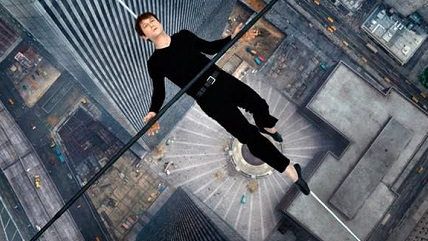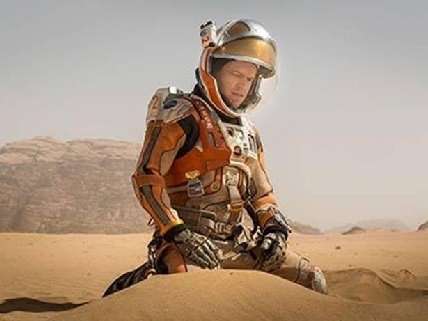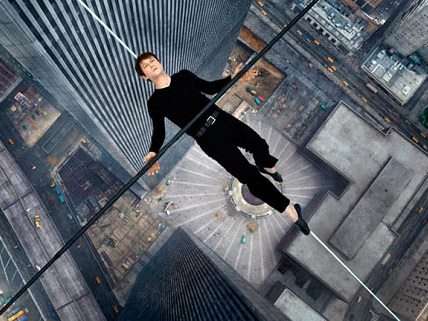Movie Reviews: The Martian and The Walk
Matt Damon conquers space, Joseph Gordon-Levitt gets high.


The Martian is a movie in which several stars are wasted. But Matt Damon carries every one of his many scenes through sheer force of personality and scrappy determination. As Mark Watney, an astronaut marooned on Mars after his crewmates leave him for dead and head back to Earth, Damon personifies a rare spirit of can-do optimism in the face of what appears to be certain doom. This is in no way your average space epic.
The movie begins with Watney in serious trouble (in which he'll remain for most of the next nearly two and a half hours). While he's pottering about outside the expedition's makeshift home base, a powerful sandstorm moves in and blows him off into the bleak Martian wastes. Regaining consciousness, he finds that his space suit and his body have been pierced by a flyaway antenna. His five fellow astronauts—ordered by faraway NASA to abort their mission, and reluctantly convinced that Watney couldn't have survived the storm—are nowhere to be seen, and his ripped suit is running out of oxygen. What to do? Watney repairs his suit on the spot, then makes his way back to the base and staples up the bloody wound in his side. Now what?
Like the 2011 Andy Weir novel on which it's based, the movie is thick with science palaver. But the flood of technical talk carries us along, because Watney uses understandable (well, fairly understandable) scientific principles to solve his many problems. For example, food—what's to eat? The base is stocked with rations for six people, but they won't last the four years he figures it would take a rescue ship to reach him—if in fact one would ever be sent. Watney is a trained botanist, however, and he finds a way. The solution turns out to be a small store of potatoes, which he plants in a mulch made of human excrement (his own, of course). "Mars will come to fear my botany powers!" he crows into the video log he's keeping.
Meanwhile, farther out in space, Watney's departed team, led by Captain Melissa Lewis (an all-business Jessica Chastain), is well into its 10-month journey home, unaware that Watney is still alive. Down in Washington, though, a NASA communications tech (Mackenzie Davis) has spotted movement on Mars, and realizes it has to be Watney. Apprised of this, NASA chief Teddy Sanders (a dull Jeff Daniels) and his press flack (Kristen Wiig, deprived of any chance to enliven the proceedings) see a PR disaster in the making: "NASA abandons stranded astronaut." Head scientist Chiwetel Ejiofor (solid as always) believes he can save the day. This involves a lot more science talk, also pretty interesting, especially when staff tech nerd Rich Purnell (a lively Donald Glover, of Community) weighs in with some really abstruse suggestions.
Things are more interesting back on Mars, though, where Watney is struggling with an oxygen shortage and creating fire and—his most complex challenge—trying to find a way to establish communication with Earth. ("I'm gonna have to science the shit out of this.") Can he overcome these problems? Who would bet against this guy?
Up until the movie's spectacular conclusion, a sort of space ballet set amid the stars and beautifully photographed by Dariusz Wolski, director Ridley Scott is surprisingly unsuccessful in creating an original vision of Mars—his rendition of the planet's rocky landscape might have been lifted whole from an old John Ford western. There are also too many characters, and too few of them memorable. Damon, though, is funny and tough, and he keeps this sometimes earthbound movie aloft.

The Walk
It's odd that there's no film footage of Philippe Petit's famous high-wire walk at the New York World Trade Center in 1974. There was a 16mm camera on hand, but somebody screwed up, and so all we have are still photographs of the young Frenchman's 45-minute balancing act on a cable strung between the tops of the 110-story Twin Towers. Now, in The Walk, director Robert Zemeckis finally brings those photos to life, or as close to it as we're likely to get. The movie is a marvel of complex and carefully controlled 3D digital imagery (do see it in IMAX), and as long as Petit is up on that wire, we're transfixed.
Unfortunately, the walk itself doesn't occur until the last third of the movie. Before that, this PG-rated film provides us with slow-rolling prologue of a sort that's almost Disneyesque in its cozy sweetness. The film begins with its star, Joseph Gordon-Levitt, as Petit, addressing us in a faux French accent while standing atop the Statue of Liberty. This excessively cute shot, to which we return throughout the movie, is immediately worrisome, and the actor probably knew it would be. So he digs into the role with staunch commitment, and before long we forget the accent—he's bright and funny and charming, much like the real Petit (who's featured in the flesh in the Oscar-winning 2008 documentary Man on Wire, which tells the same story at considerably shorter length).
We meet Petit in 1973, working as a street performer in Paris—doing magic tricks, juggling, zipping around on a unicycle. We flash back to scenes with his wire-walking mentor, a crusty Czech circus star called Papa Rudy (Ben Kingsley, deploying an accent from a country of his own devising). When Philippe spots a magazine story about the near-completed World Trade Center, he's immediately inspired—one day he weel conquer zose towers! In a hyper-Parisian plaza he meets a street-singing art student named Annie (Charlotte Le Bon), and in a rush of wine and candles and rivulets of rain running picturesquely down a café window, they fall in love. He recruits her to join him in staging his big stunt, and before long has drawn in other "accomplices," among them a school teacher who's afraid of heights (César Domboy) and, in New York when he arrives, a bilingual shop clerk (James Badge Dale) and an elaborately mustachioed insurance agent who happens to work on a high floor in one of the towers (Steve Valentine).
The immediate run-up to the main event—the illicit reconnaissance of the towers, the infiltration of equipment, the rigging of the cable—is tensely engrossing, although if you've seen Man on Wire, you'll learn nothing new here. The movie doesn't really take wing until Petit steps out on that wire, with all of downtown New York sprawling far below him. The vibrant detail in which the city has been digitally rendered is thrilling in itself, and the seamlessness with which the live action has been incorporated—with Petit kneeling on the wire midway, then lying down on it, then making it all the way to the opposite tower and then turning around and doing it again, and again—makes this recreated feat as breathtaking as those long-ago photos suggest that it actually was.


Show Comments (2)